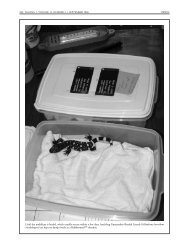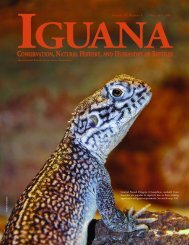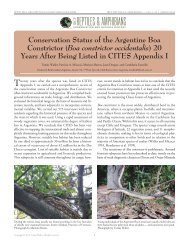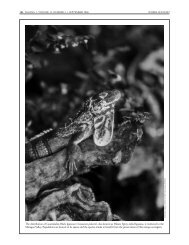Spiny-tailed Iguanas (Ctenosaura similis) in Venezuela
Spiny-tailed Iguanas (Ctenosaura similis) in Venezuela
Spiny-tailed Iguanas (Ctenosaura similis) in Venezuela
You also want an ePaper? Increase the reach of your titles
YUMPU automatically turns print PDFs into web optimized ePapers that Google loves.
SUZANNE L. COLLINS, CNAH<br />
182 IGUANA • VOLUME 15, NUMBER 3 • SEPTEMBER 2008 NEWSBRIEFS<br />
Copperheads (Agkistrodon contortrix) are frequently<br />
handled <strong>in</strong> a small number of fundamentalist<br />
churches who trust that true<br />
believers can take up serpents without be<strong>in</strong>g<br />
harmed.<br />
Middlesboro, where a Tennessee woman<br />
died after be<strong>in</strong>g bitten by a rattlesnake<br />
dur<strong>in</strong>g a service <strong>in</strong> 1995. Her husband<br />
died three years later when he was bitten<br />
by a snake <strong>in</strong> northeastern Alabama.<br />
Coots was charged Thursday with buy<strong>in</strong>g,<br />
sell<strong>in</strong>g, and possess<strong>in</strong>g illegal reptiles.<br />
He had no listed telephone number and<br />
could not be reached for comment.<br />
The snakes, plus one alligator, were<br />
turned over to the nonprofit Kentucky<br />
Reptile Zoo <strong>in</strong> Slade. Most appeared to<br />
have been captured from the wild, with<br />
some imported from Asia and Africa.<br />
Zoo Director Jim Harrison said some of<br />
the animals would likely have become<br />
exotic pets had they not been seized.<br />
“There’s been a large trade <strong>in</strong> exotics for<br />
years,” he said. “Some people are just fasc<strong>in</strong>ated<br />
with them.” “You can purchase<br />
anyth<strong>in</strong>g off the Internet except common<br />
sense,” Harrison said. “A venomous<br />
snake isn’t a pet. You don’t play with it. If<br />
you do, you’re an idiot.”<br />
Butler’s Garter Snake <strong>in</strong> Trouble<br />
The Wiscons<strong>in</strong> Department of Natural<br />
Resources (DNR) is chang<strong>in</strong>g the way it<br />
<strong>in</strong>terprets its authority and def<strong>in</strong>ition of<br />
“Take” under the Wiscons<strong>in</strong> Endangered<br />
Species Law, and is propos<strong>in</strong>g a new “regulatory<br />
framework” for the Butler’s<br />
Garter Snake (Thamnophis butleri).<br />
These changes would remove most protections<br />
for habitat utilized by endangered<br />
and threatened species, substantially<br />
reduc<strong>in</strong>g the Department’s<br />
regulatory jurisdiction. The new Butler’s<br />
Garter Snake “framework” would allow<br />
unregulated development of most upland<br />
habitat utilized by the snake for its life<br />
cycle. The Department has begun implement<strong>in</strong>g<br />
these changes without public<br />
notice.<br />
The proposed “regulatory framework”<br />
is based on a new legal <strong>in</strong>terpretation<br />
of “Take” and the Department’s<br />
jurisdiction, which suggests that if no<br />
animals are immediately and obviously<br />
killed by an action, a “Take” is avoided<br />
and the Department has no authority,<br />
even if the actions result <strong>in</strong> significant<br />
harm to the resource, or deaths that are<br />
not immediately observed. This new<br />
<strong>in</strong>terpretation does not acknowledge that<br />
destroy<strong>in</strong>g a species’ habitat harms <strong>in</strong>dividuals<br />
of the species, and does not<br />
acknowledge that a “Take” occurs when<br />
mortality results when <strong>in</strong>dividuals return<br />
to a lost habitat area and cannot f<strong>in</strong>d<br />
food or shelter, and through loss of<br />
reproductive potential and <strong>in</strong>creased<br />
mortality from overcrowd<strong>in</strong>g <strong>in</strong> rema<strong>in</strong><strong>in</strong>g<br />
habitat (if any rema<strong>in</strong>s). Such mortality<br />
would be a direct result of the unregulated<br />
habitat loss. The Department also<br />
takes no account of cumulative harm,<br />
jeopardy, or viability of the resource<br />
result<strong>in</strong>g from these habitat and population<br />
losses. This new <strong>in</strong>terpretation<br />
essentially removes protections for all<br />
endangered and threatened species <strong>in</strong><br />
many, if not most, situations. It allows a<br />
person to simply shoo an animal off, or<br />
wait for it to walk, crawl, or fly away, perhaps<br />
to get a dr<strong>in</strong>k of water, and then<br />
destroy the habitat upon which it<br />
depends. For the Butler’s Garter Snake,<br />
which feeds almost exclusively on earthworms<br />
(which do not occupy saturated<br />
wetland soils), upland habitat is crucial<br />
for obta<strong>in</strong><strong>in</strong>g food and shelter, and <strong>in</strong>cubat<strong>in</strong>g<br />
embryos. The snakes depend on<br />
grasses and other vegetation for shelter<br />
from predators. Pregnant females seek<br />
warm upland sunlit areas adjacent to<br />
grasses (to which they flee when disturbed).<br />
Such bask<strong>in</strong>g sites are crucial to<br />
embryonic development <strong>in</strong> this ectothermic<br />
species so proper temperatures can<br />
be achieved. Loss of upland habitat<br />
would crowd snakes <strong>in</strong>to wetlands, where<br />
many would succumb to lack of food<br />
and shelter from the elements, overcrowd<strong>in</strong>g,<br />
and <strong>in</strong>creased predation.<br />
Snakes hidden with<strong>in</strong> upland soil and<br />
duff retreats at the time of grad<strong>in</strong>g, where<br />
they take shelter for the night, sit out<br />
periods of hot dry weather, and hibernate,<br />
would simply be crushed by heavy<br />
equipment.<br />
The DNR has issued a “regulatory<br />
framework” for selected (stakeholder)<br />
public review. They are hold<strong>in</strong>g meet<strong>in</strong>gs<br />
about it with stakeholders, and state they<br />
will develop a new broad authorization<br />
based on it after comments are received.<br />
The new broad authorization will be<br />
public noticed and vetted by the Natural<br />
Resources Board (NRB). If similar to the<br />
“framework” be<strong>in</strong>g distributed, this<br />
broad authorization will automatically<br />
approve the “Take” that results from<br />
projects that follow certa<strong>in</strong> m<strong>in</strong>imization<br />
measures, such as snake fenc<strong>in</strong>g, snake<br />
removals, and stay<strong>in</strong>g 300 feet away from<br />
wetland boundaries. However, the<br />
Department, by a form letter be<strong>in</strong>g distributed<br />
to parties currently <strong>in</strong> the<br />
Butler’s Garter Snake approval process,<br />
appears to be implement<strong>in</strong>g the substance<br />
of the proposed new broad<br />
authorization before it is public noticed<br />
or reviewed by the NRB.<br />
The “regulatory framework” lists a<br />
number of measures that m<strong>in</strong>imize<br />
“Take” of snakes. The draft regulatory<br />
framework correctly refers to these as<br />
avoidance measures that m<strong>in</strong>imize<br />
“Take,” but the form letter contradicts<br />
this and states that these measures actually<br />
avoid “Take.” As a po<strong>in</strong>t of fact,<br />
these measures do not avoid “Take,” they<br />
only m<strong>in</strong>imize it. The Department’s own<br />
research, for example, documented that<br />
snakes occupy habitat more than 300 ft<br />
from a wetland boundary (Joppa and<br />
Temple. 2005. Use of upland habitat by<br />
Butler’s Garter Snake (Thamnophis butleri).<br />
Bullet<strong>in</strong> of the Chicago Herpetological<br />
Society 40:221–227), and ample evidence<br />
exists of snakes cross<strong>in</strong>g fence l<strong>in</strong>es and<br />
over-w<strong>in</strong>ter<strong>in</strong>g <strong>in</strong> uplands. The <strong>in</strong>correct<br />
portrayal of m<strong>in</strong>imization measures as<br />
complete avoidance is the basis for the<br />
removal of protections, and unsupported<br />
by science.<br />
The Wiscons<strong>in</strong> Department of Natural<br />
Resources (DNR) is propos<strong>in</strong>g a new “regulatory<br />
framework” for the Butler’s Garter<br />
Snake (Thamnophis butleri) that would<br />
remove most protections for habitat utilized<br />
by this and other endangered and threatened<br />
species.<br />
GARY CASPER








